Health Topics
-
Healthy Living
-
|
| |
| Stuffy Nose Affecting Work? |
| Dr Sreedevi Yadavalli |
| |
 |
Picture this: You are in the midst of an internal meeting at the workplace. Your boss or senior colleague is espousing the virtues of his latest idea on cost-cutting measures. |
|
Slowly, his voice lapses into a drone that gets muter, even while his animated face steadily starts to blur before your eyes. Suddenly, you snap to attention, embarrassed at catching yourself nodding off. You look around furtively to ensure no one noticed, while reaching out for the coffee.
The vicious cycle of nasal spray/ drops addiction
- Just a couple of drops of the decongestant, can shrink the swollen tissues in a matter of seconds, and instantly provide relief by letting in a gush of fresh air into the airway.
- It works so well that you tend to keep using it, even though for some medications a single dose provides relief for almost 12 hours.
- Because you breathe well with the drops, you tend to use it more often, and in increased quantity.
- After some days of continuous use, the drops can cause the nasal linings to swell up again, even when the cold or attack of sinusitis or allergy that originally caused the problem has passed.
- So because the congestion doesn’t seem to clear up, you increase the frequency and dosage of your drops.
How to break the cycle
- Simply stop cold turkey to defuse the rebound cycle in a week or two.
- Consult your doctor who may put you on nasal steroid spray or sometimes on a short oral steroid course that will relieve the stuffiness until the rebound is gone.
- Use saline drops to keep the nasal passages moisturized and help the tissues recover.
|
|
Seems familiar? Well, you could be experiencing symptoms of an obstructed nasal passage. But how can a stuffy nose be responsible for dozing off at work?
Dr Kumaresh Krishnamoorthy, Senior Consultant in ENT – Neurotology and Head & Neck Surgery, Apollo Hospitals, Bengaluru, says that nasal obstruction is an upper airway condition that can be caused by a variety of maladies such as allergies, sinusitis, or even a deviated septum.
Such maladies cause inflammation of the mucous membranes of the nose, which cover the nasal turbinates that are small, shell-like bony structures protruding into the nasal airway.
In normal conditions, these nasal turbinates help to warm, humidify and cleanse the air we inhale before it reaches our lungs. But in patients with severe allergies or other problems, the turbinates can swell up, blocking the airway.
“The problem can have great impact in negatively affecting work and social activities,†says Dr Kumaresh. “A chronic stuffy nose can impair normal breathing, forcing patients to breathe through the mouth, and turn the simple acts of eating, drinking and speaking into an annoying and sometimes painful experience.†Not only are patients known to be affected throughout the day, but most are likely to suffer from sleep disorders at night too. This is because the congestion gets worse on lying down. So, it is fairly common for patients with chronic nasal obstruction to experience snoring and obstructive sleep apnea - suspension of breathing during sleep - which only contributes to the daytime sleepiness. |
| |
|
The medical management for this condition usually consists of
- Decongestants: These medicines shrink the blood vessels in the lining of the nose for relieving the stuffiness, though they may not help a runny nose or other symptoms
- Antihistamines: To reduce the amount of mucus, though most antihistamines contribute to drowsiness
- Saline nasal sprays: To loosen thick mucus
- Steam inhalation: To increase the humidity in the inspired air Nevertheless, once turbinate enlargement becomes chronic, it is irreversible except with surgical intervention called turbinectomy.
|
|
The procedure opens up the nasal passages by removing or reducing and re-sizing the enlarged bone and soft tissue sponges. “Turbinectomy may be achieved by cauterization, laser or microdebrider, though of these, laser turbinoplasty is more likely to provide longer lasting relief,†says Dr Kumaresh.
Amarendra, a patient who recently underwent the procedure says, “I feel much better now after the surgery (laser turbinate compression surgery) that I underwent about a month ago. I’ve been suffering from this problem since my childhood days, with no relief in spite of using nasal sprays. I would feel some irritation and a ‘burning’ sensation inside my nose. All of it now seems to be gone.â€
Such cases are not unusual, as Dr Kumaresh points out. “Extended use of decongestants meant to constrict the blood vessels in the lining of the nose may end up causing rhinitis medicamentosa – a condition of rebound nasal congestion,†he elaborates.
Apparently, patients suffering from nasal obstruction who are advised nasal drops end up overusing them. This is because, though the drops offer temporary relief from congestion, once the effect wears off, they again experience stuffy nose symptoms caused by turbinate enlargement. To counter this, they increase both the dose and the frequency of the nasal drops, which worsens the rhinitis medicamenta.
To break the vicious cycle, doctors advise discontinuation of the decongestant drops. Sometimes, they are advised oral decongestant medication to help with the transition, though laser turbinectomy surgery is recommended for a more lasting solution to the problem. |
| |
|